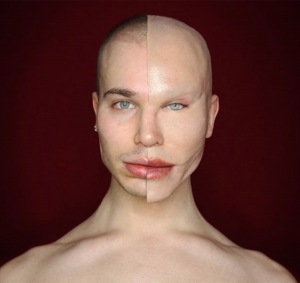
Drag artist Alexis Stone reveals fake plastic surgery transformation
By Roshni Riar, Staff Writer
If you’ve had Instagram in the past year, you’ve probably seen an Alexis Stone makeup shot. In 2018, the British drag and makeup artist—whose real name is Elliot Joseph Rentz—became known online for their impressive makeup transformations into celebrities like Joan Rivers, Nicki Minaj, and Cher. A particularly well-received transformation into Kim Kardashian garnered so much attention that it landed Stone on the cover of Tush, painted as Kardashian herself.
Through their rise to fame, Stone has been no stranger to criticism. Dabbling with cosmetic procedures such as Botox, nose jobs, and cheek fillers to help enhance their look, they were often met with scalding Instagram comments. In the face of this constant judgement, Stone decided to attempt a transformation like no other before: Faking extreme plastic surgery à la Jocelyn Wildenstein, whom Stone has repeatedly cited as a style inspiration.
In an interview with Paper, Stone said, “When I sat down and decided I wanted to show these severe transformations, I was about two weeks into sobriety. […] This project and my sobriety went hand-in-hand. Before I had any plastic surgery, people called me a ‘botch monster.’”
Stone said they embraced this vicious name-calling in their own fashion.
“When I got [plastic surgery], people called me a botch monster. So, I took things that were already there and I ran with it. I said, fuck it, let me take this rumour, this accusation, this comment, and let me give you what you want.”
Enlisting the help of David Martí—an Academy Award-winning makeup artist best known for his work on Pan’s Labyrinth—Stone set out to create a new face. Martí, based in Barcelona, began by making casts of Stone’s face, later modelling a new face with silicon so it could be easily put on and painted over.
The transformation began in mid-October 2018, when Stone publicly announced they were heading into surgery. Martí went so far as to send Stone a prosthetic face that looked freshly recovered from plastic surgery, which Stone wore for a photo posted to their Instagram assuring everyone the surgery “went smoothly and on schedule.”
On November 10, Stone uploaded a photo with their main prosthetic face applied. The caption underneath the photo expressed that Stone hadn’t “felt this happy and confident in years”—but the comments had little regard for their happiness.
As Stone began regularly uploading content with their new face, comments such as “Destroyed face!”, “Why would you do this to your face?”, “You’ve ruined your life!”, and “You are mentally ill!” began flooding in, overshadowing those who supported Stone’s happiness.
The public was convinced; Martí’s prosthetics were incredibly realistic and Stone took the extra measure to wear them out in public in order to keep up the illusion. The two-month project—which saw 22 photos and four YouTube videos featuring Stone’s new face—was laden with violent hatred and judgement.
Stone lost friends, relationships, followers, brand deals, and paid sponsorships while simultaneously navigating through the toxicity being hurled at them whenever they uploaded a photo or video with their prosthetic face. Not only was it personally taxing, but Stone’s livelihood was negatively affected in the process.
A one-minute YouTube video titled “The Stone Age” was uploaded on Instagram and Facebook on New Year’s Eve—initially understood as a brand deal between Stone and The Crème Shop—opening on Stone slowly smoking a cigarette before looking to the camera and ripping off the prosthetic face. As one would think, the internet’s amazement spread like wildfire.
Stone has gained over 40,000 followers since the New Year’s Eve reveal, which doesn’t yet come close to making up the 60,000-plus followers they lost over the few months they were uploading photos with their “new” face. The spike in new and returning followers is also bringing in an outpouring of love, with many people praising them for their experiment and apologizing for judging them.
A recently uploaded YouTube video, The Making of Alexis Stone, chronicles the decision-making and creation of the new face, capturing a lot of Stone’s raw emotional responses to the situation. Throughout the 35-minute YouTube video, they appear nervous, thoughtful, and excited for what the project could bring. It ends at the initial reveal in November, and fans have been urging Stone to release more footage of the transformation period.
Stone viewed this project as just another transformation, like the many that propelled them into Insta-fame. This one simply didn’t receive the acclaim that turning into Johnny Depp or Ellen would have. They have stated in interviews that they believe this reception speaks to the judgement and narrow standards surrounding cosmetic surgeries. Comparing the project with what landed them in the spotlight, they see all their work on Instagram in the same light—as transformative performance art.



